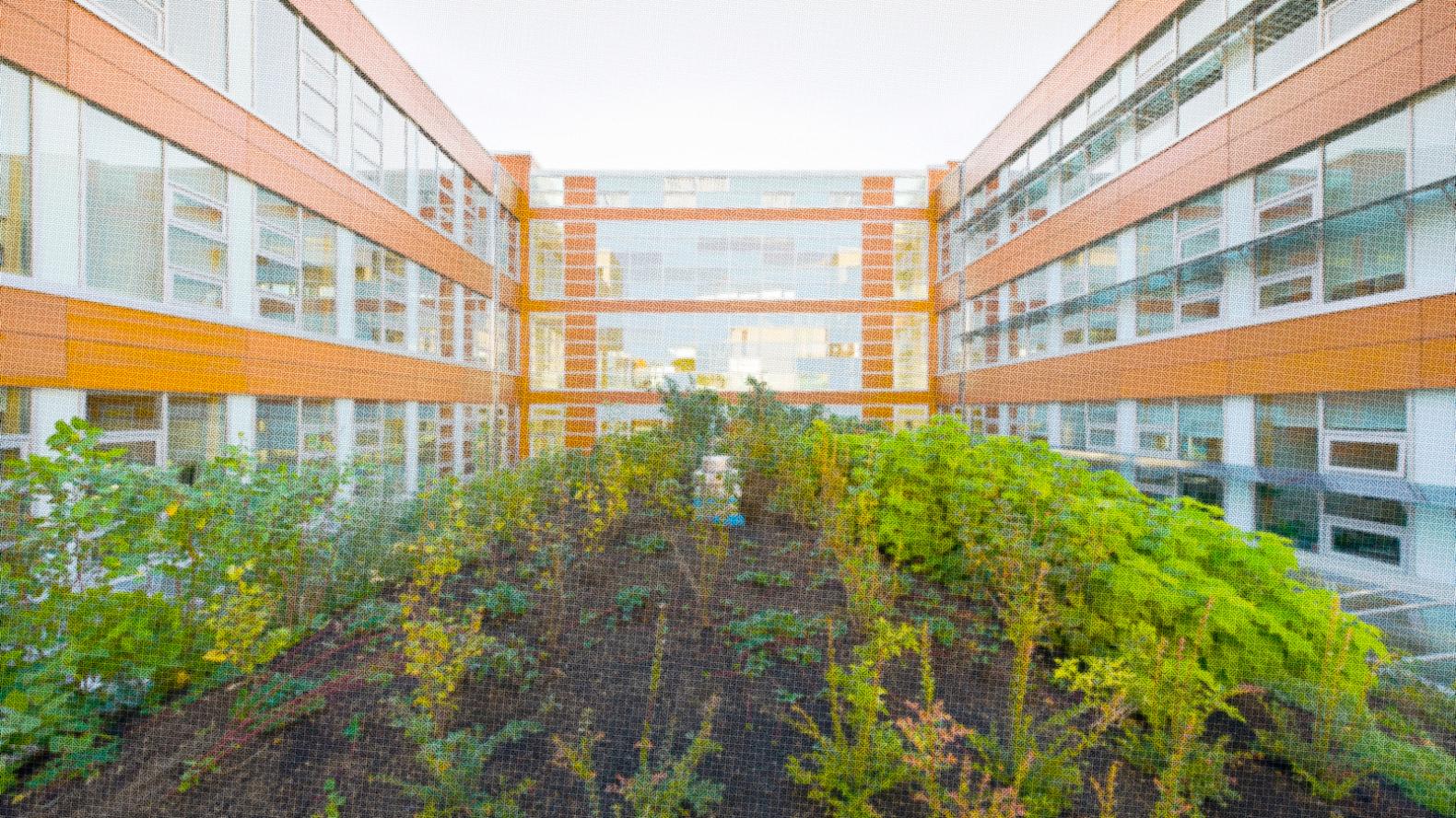
During #climatestrike week, we’re taking stock of the climate action work we’ve done so far, and challenging ourselves to understand how we can be more effective and have greater impact through our climate action commitments.
#climatestrike week highlights the crisis we are in. Global carbon emissions have never been higher and show no sign of peaking yet.[1] Sea levels are rising, coral reefs are dying, and we are starting to see the life-threatening impact of climate change on health through air pollution, heatwaves, and risks to food security.[2] Scientific models indicate we must act to drastically reduce emissions now in order to avoid warming of greater than 1.5oC by 2030.[3]
We’re using this week to host #climatestrikeconversations and invite students, staff, and faculty to join in.
We’re posing some important questions and inviting you to help shape our existing programs and to inform our future actions. Your ideas will inform conversations with decision-makers across UBC, and externally with partner organizations.
What we do can make a difference both here on campus and beyond, through our contribution to advancing the global Sustainable Development Goals, and through our ability to influence others as an agent of change across our region and beyond.
Here’s some of the questions on our mind this week. We hope you’ll join us.
#1 climatestrike and GHGs
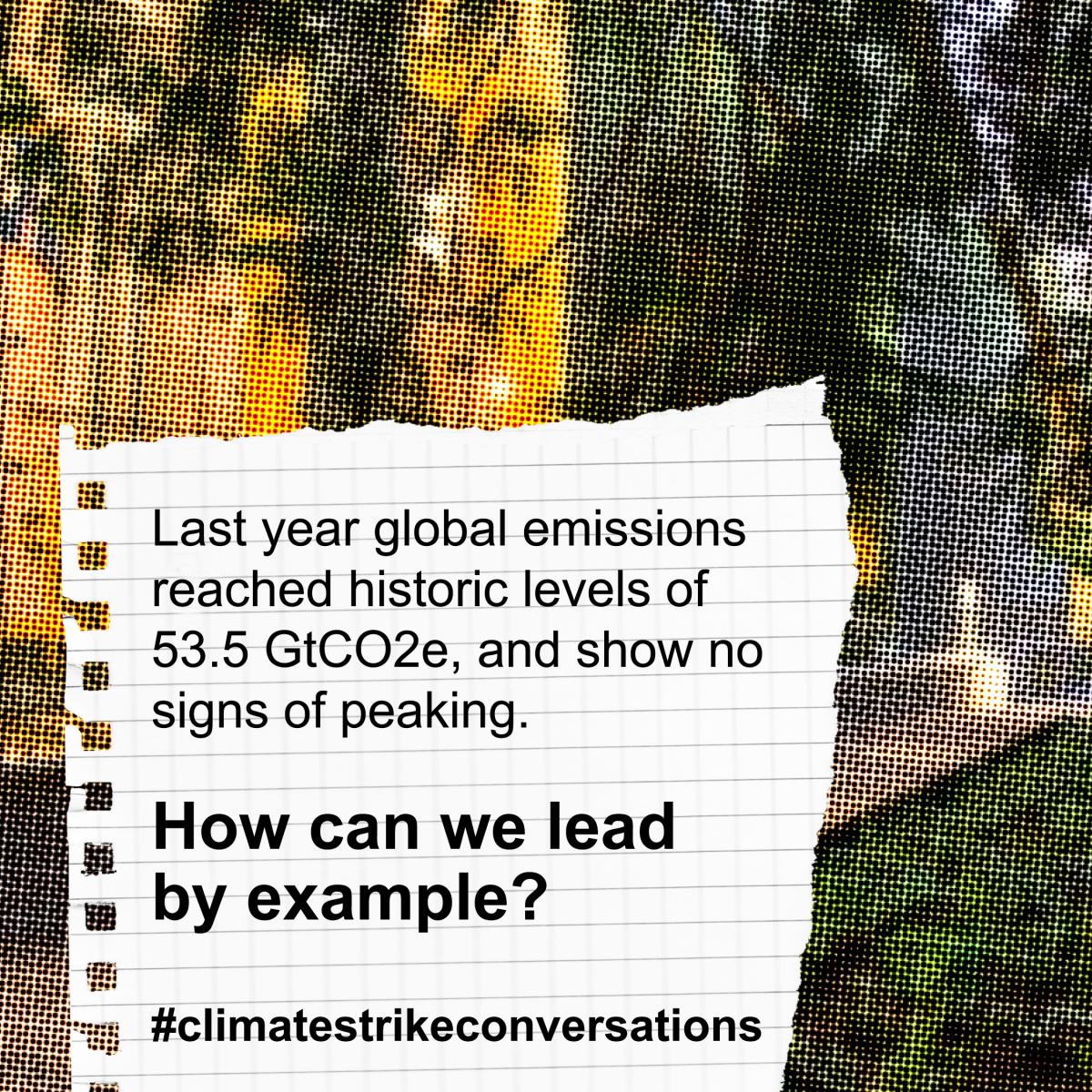
Last year global emissions reached historic levels of 53.5 GtCO2e and show no signs of peaking.[4] How can we lead by example?
UBC has reduced GHG emissions by 38% since 2007, and we’re expanding our bioenergy plant and implementing our Green Building Action Plan to advance towards cutting emissions by 67% by 2020. So far, this has largely been achieved by converting from a 90 year-old steam system to a highly efficient hot water district energy system, displacing the use of fossil fuels with bioenergy, and implementing behavioral change programs with a focus on energy and carbon reductions across our Vancouver campus. By 2050, we’re aiming to reduce GHG emissions by 100%.
But it will take a huge effort by everyone on campus to reach this aggressive goal. What else can we all do to reduce emissions as fast as possible?
Reach out to us using #climatestrikeconversations and let us know.
#2 climatestrike and transportation
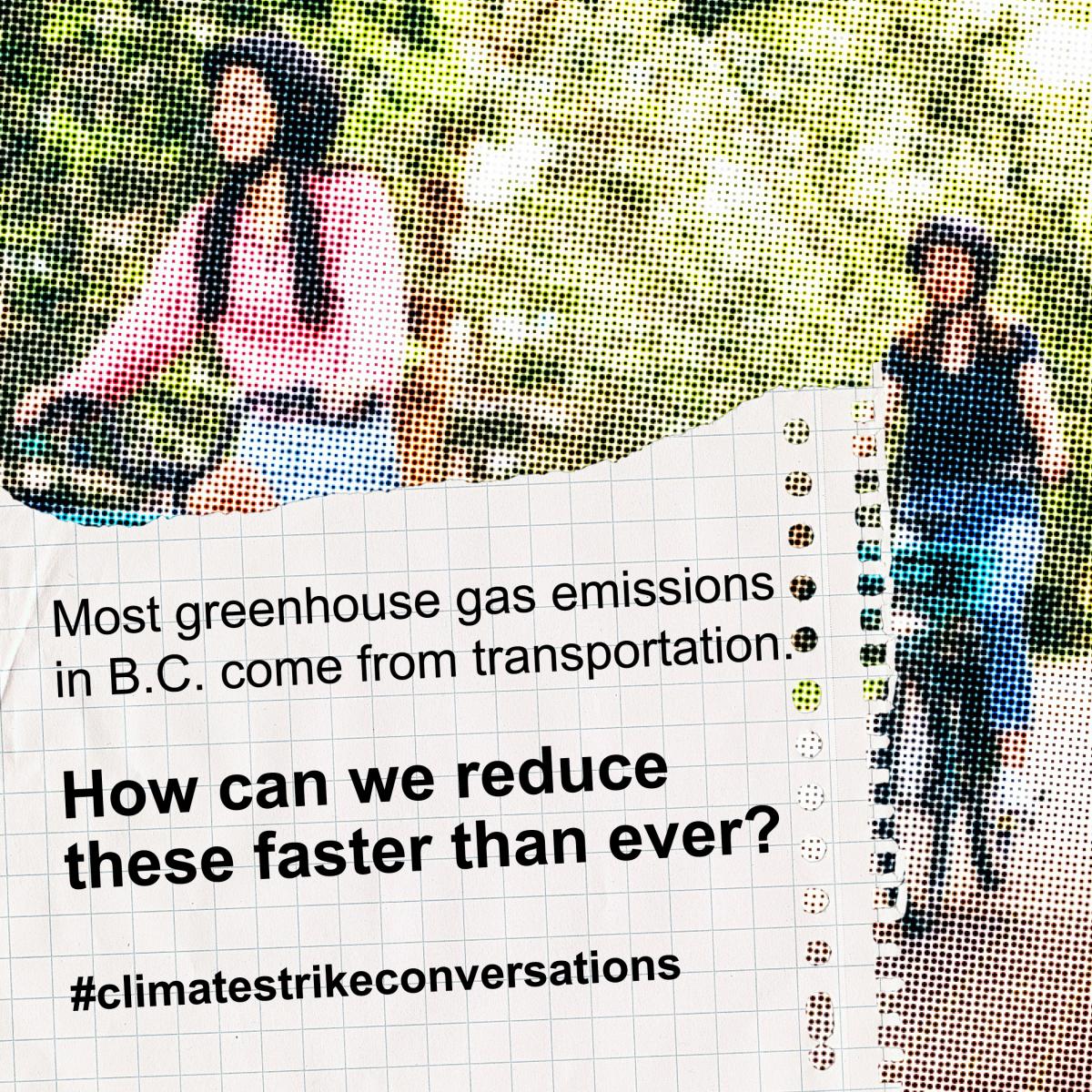
Most greenhouse gas emissions in B.C. come from transportation.[5] How can we reduce these faster than ever?
UBC is a regional leader in sustainable transportation. In 2018, two thirds of trips to and from our Vancouver campus were made by sustainable modes of transport. This is largely the result of promoting the UPass, cycling, bikesharing, and reducing commuting by continuing to build more housing on campus for students, faculty and staff. Our advocacy to bring the SkyTrain to UBC will help increase this trend, reducing congestion, GHG emissions and air contaminants while improving personal health and wellbeing for the campus community, our region, and beyond.
However, the number of single occupant vehicles is still increasing and are now 5% above 1997 values. We know that transportation emissions are critical to addressing the impacts of climate change and minimizing car journeys is key to this. What else can we all do to reverse this trend?
Reach out to us using #climatestrikeconversations and let us know.
#3 climatestrike and applied research
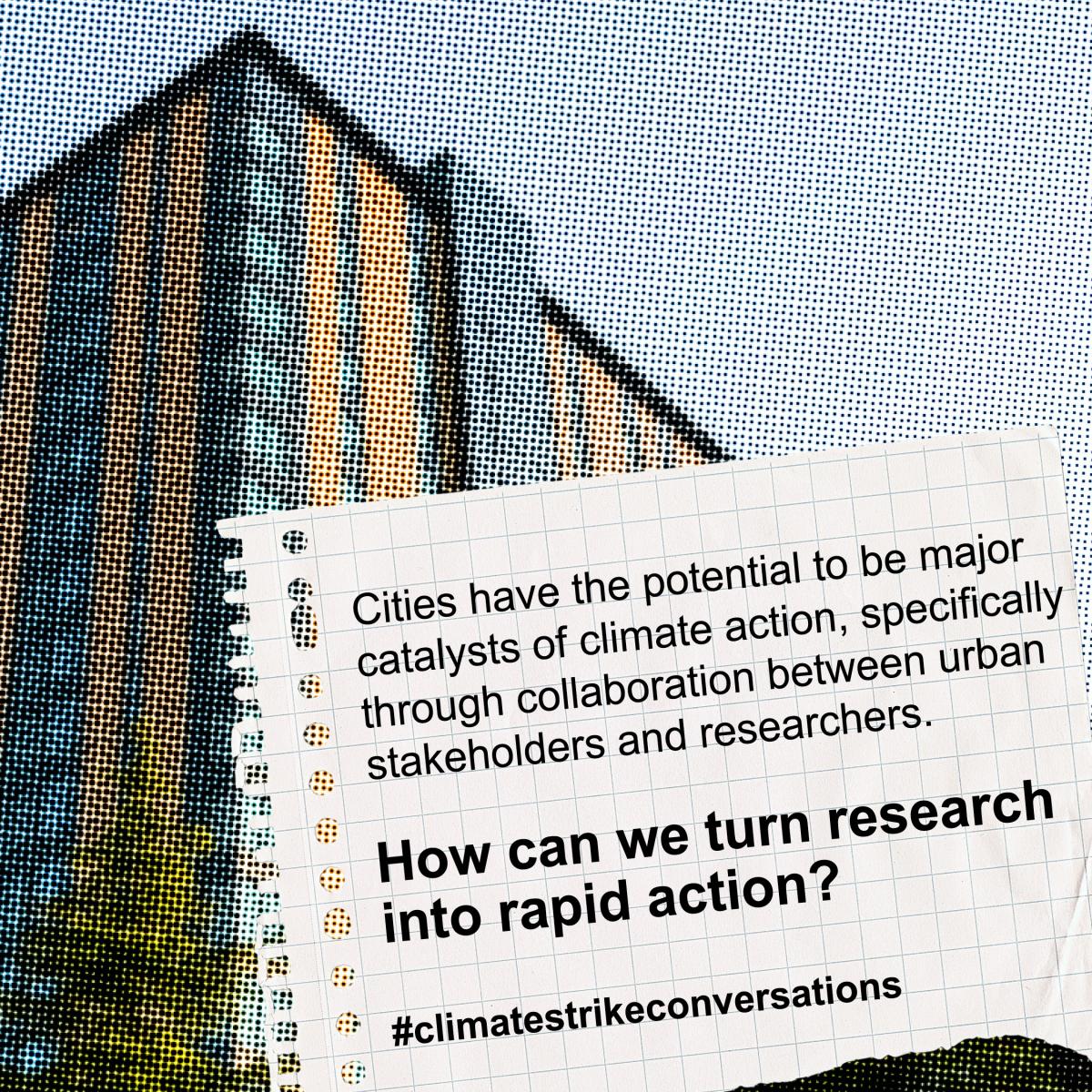
Cities have the potential to be major catalysts of climate action, specifically through collaboration between urban stakeholders and researchers.[6] How can we turn research into rapid action?
UBC currently has 374 faculty researching sustainability-related topics, not to mention hundreds of students that make climate action research part of their UBC experience through programs like the SEEDS and Sustainability Scholars programs. And we have 40+ faculty-led research groups, including the UBC Clean Energy Research Centre, and partnerships e.g. ZebEx that aim to put low carbon research to work by inspiring developers, builders, architects and designers to adopt green practices.
But during #climatestrike week we’re asking ourselves: How else can we turn research into rapid action?
Reach out to us using #climatestrikeconversations and let us know.
#4 climatestrike and green buildings
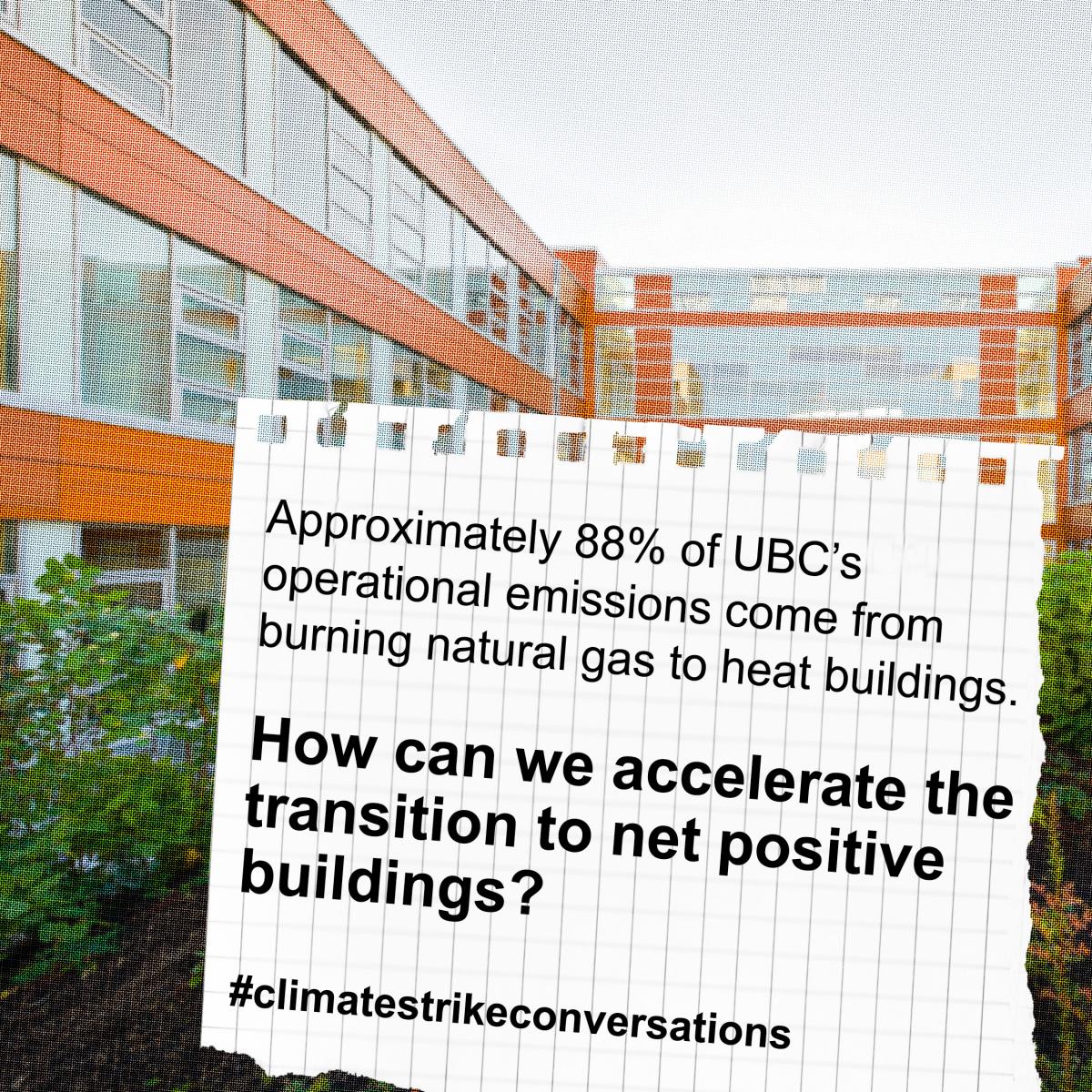
Approximately 88% of UBC’s operational emissions come from burning natural gas to heat buildings.[7] How can we accelerate the transition to net positive buildings?
UBC students, faculty, staff and residents have worked hard to design a new Green Building Action Plan with a bold vision: by 2035, UBC’s buildings will make net positive contributions to human and natural systems. The plan covers eight distinct areas, including energy and climate adaptation, and targets all new buildings to be net carbon positive ready by 2030.
UBC’s Green Building Action Plan identifies actions to address energy and carbon in both new and existing buildings. In fact, building recommissioning and energy retrofits so far have eliminated over nine percent of campus GHG emissions compared to 2007 levels.
But given there are more than 500 legacy buildings across campus, how do we make the biggest impact with limited resources?
Reach out to us using #climatestrikeconversations and let us know.
#5 climatestrike and our daily choices
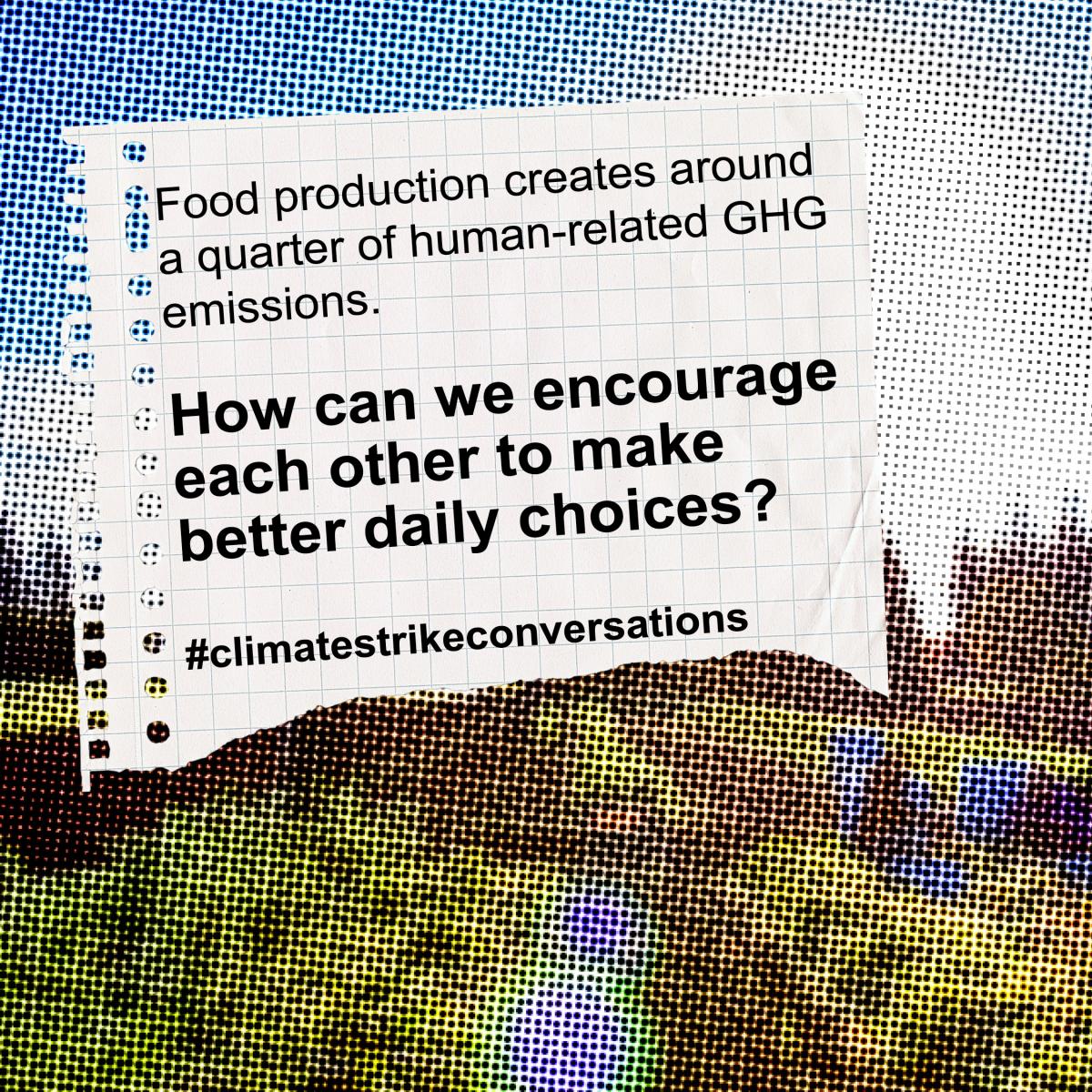
Food production creates around a quarter of human-related GHG emissions.[8] How can we encourage each other to make better daily choices?
Every day we get up, wash, eat, sleep, repeat. Our daily choices contribute to our carbon footprint, and together those emissions add up to have a significant impact.
At UBC we run a number of campaigns and programs to encourage people to live a low carbon lifestyle. These include sorting food waste so we can compost it, taking a shorter shower (5 mins or less!), turning down the thermostat in buildings and throwing on a sweater, turning up the thermostat in labs to lower refrigeration emissions, and making our offices and residences more sustainable.
But how can we improve these programs? What else should we ask people to do, and how can we encourage them to change their behaviour right now?!
Reach out to us using #climatestrikeconversations and let us know.
#6 climatestrike and using our campus as a living lab
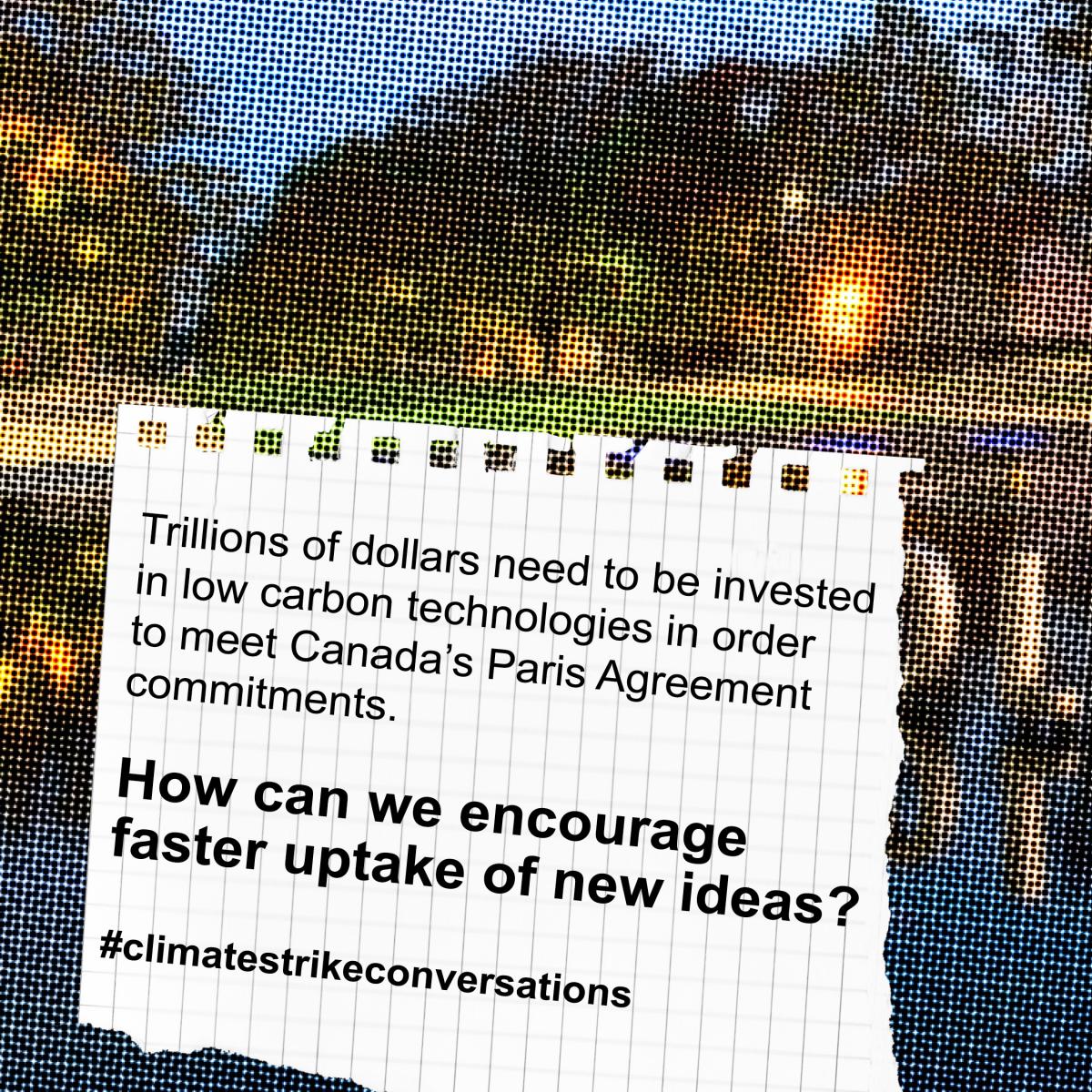
Trillions of dollars need to be invested in low carbon technologies in order to meet Canada’s Paris Agreement commitments.[9] How can we encourage faster uptake of new ideas?
UBC is uniquely suited to act as a living laboratory. We own and operate our own utilities including electrical, heating, water and waste, and as a research institution we’re able to take risks and learn quickly from implementing new technologies and innovations in design.
Recent projects include Tallwood House, a mass timber student residence building; building a new multifamily residential rental housing built to low carbon passive house standards, to better understand how to build affordable, low carbon, high performance residential buildings, expanding our biomass energy facility, shifting away from our operational dependence on natural gas, divesting campus reliance on fossil fuels, and testing a new solar panel parkade to support electric vehicle adoption.
But how can we further accelerate adoption of these technologies beyond our campuses?
Reach out to us using #climatestrikeconversations and let us know.
#7 climatestrike and advocacy
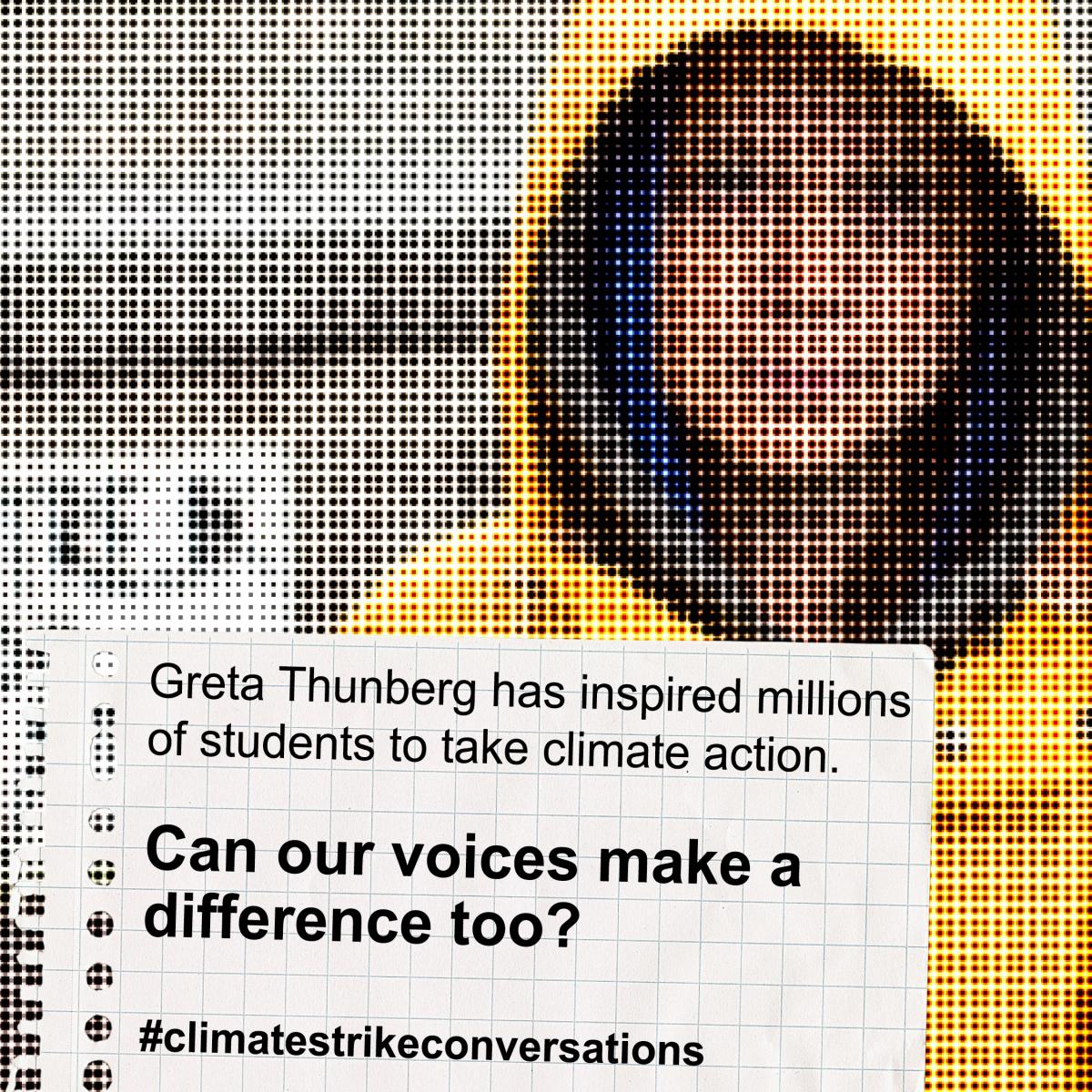
Greta Thunberg has inspired millions of students to take climate action. Can our voices make a difference too?
UBC supports a number of student-led advocacy groups to raise awareness of sustainability issues, including climate action. Last year the Sustainability Ambassadors organized a campaign to promote the UN Sustainable Development Goals, and the Climate Hub hosted the first ever UBC Climate Solutions Showcase. In addition, UBC is advocating for the SkyTrain extension to our Vancouver campus in order to reduce congestion, GHG emissions, and air contaminants.
But what other advocacy roles can UBC students, staff, and faculty play? Where can our voices have the biggest impact?
Reach out to us using #climatestrikeconversations and let us know.
#8 climatestrike and working in partnership
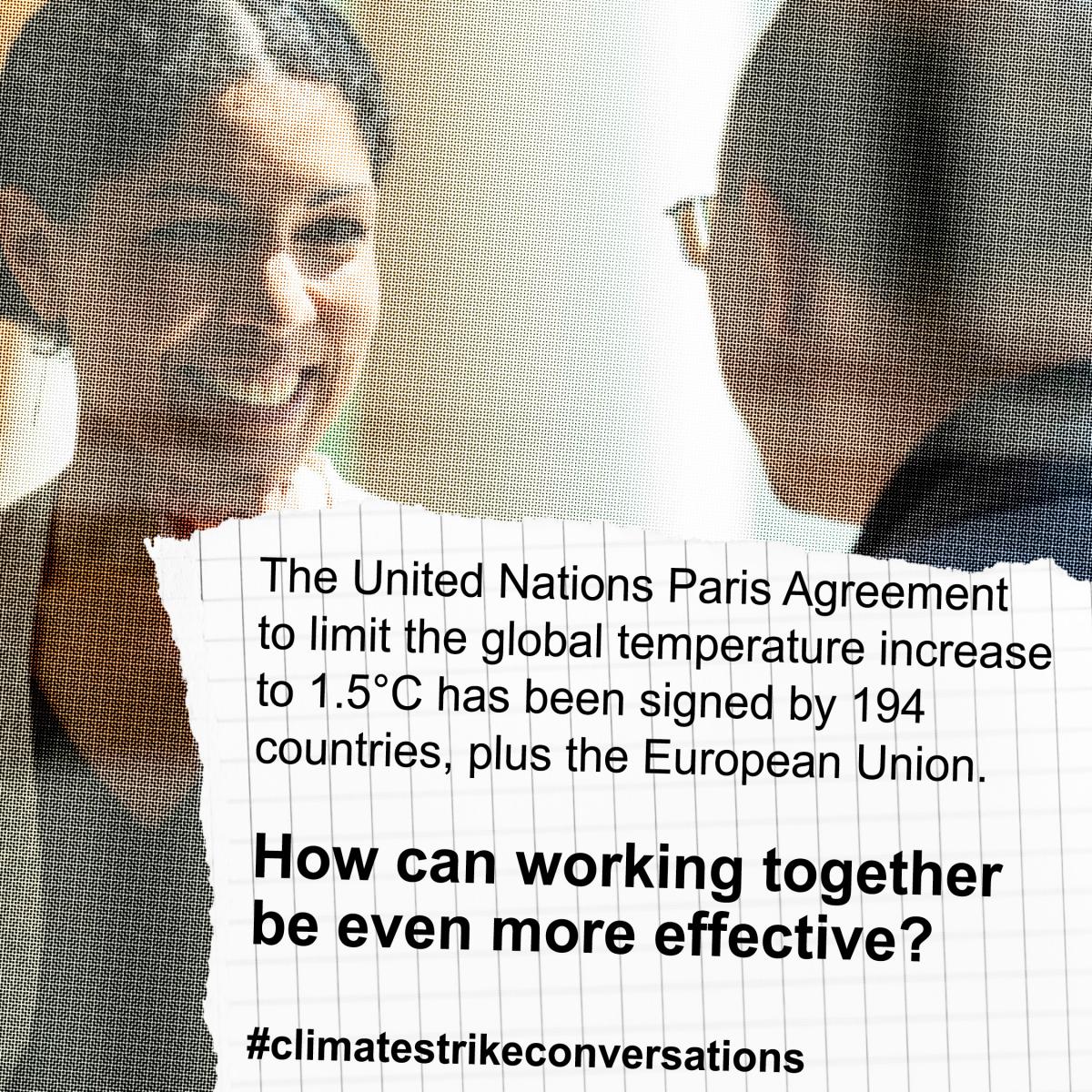
The United Nations Paris Agreement to limit the global temperature increase to 1.5oC has been signed by 194 countries, plus the European Union.[10] But how can working together be even more effective?
UBC is working in partnership with a large number of organizations across BC, Canada, and across the world to advance climate action. These include our membership of international groups like the Universities Climate Change Coalition, the International Sustainable Campus Network, as well as convening regional groups through our participation in the Emerald Corridor, and our own President’s Roundtable on Climate Action.
But how can working together be even more effective? What can UBC do to make our partnerships even stronger?
Reach out to us using #climatestrikeconversations and let us know.
#9 climatestrike and education

Gen Z will make up 40% of the working and consumer population by 2020.[11] How can teachers today prepare students for a rapidly unfolding future characterized by change and uncertainty?
UBC offers over 650 courses related to sustainability, many of which include issues related to climate change. In addition, there are a number of student clubs and engagement programs that provide students with the opportunity to put their climate-related learning experience into action.
What will be relevant and useful in the context of large-scale social and environmental change? How can teachers today prepare students for the uncertainty of tomorrow?
Reach out to us using #climatestrikeconversations and let us know.
Footnotes
[1]“UN Environment Emissions Gap Report,” United Nations, www.un.org/sustainabledevelopment/climate-facts-and-figures/, (November, 2018)
[2]“UN Climate Action Summit,” United Nations, www.un.org/en/climatechange/un-climate-summit-2019.shtml, (September, 2019)
[3]IPCC, 2018: Summary for Policymakers. In: Global Warming of 1.5°C. An IPCC Special Report on the impacts of global warming of 1.5°C above pre-industrial levels and related global greenhouse gas emission pathways, in the context of strengthening the global response to the threat of climate change, sustainable development, and efforts to eradicate poverty [Masson-Delmotte, V., P. Zhai, H.-O. Pörtner, D. Roberts, J. Skea, P.R. Shukla, A. Pirani, W. Moufouma-Okia, C. Péan, R. Pidcock, S. Connors, J.B.R. Matthews, Y. Chen, X. Zhou, M.I. Gomis, E. Lonnoy, T. Maycock, M. Tignor, and T. Waterfield (eds.)]. https://www.ipcc.ch/site/assets/uploads/sites/2/2019/05/SR15_SPM_version_report_LR.pdf(May, 2019)
[4]“UN Environment Emissions Gap Report,” United Nations, www.un.org/sustainabledevelopment/climate-facts-and-figures/, (November, 2018)
[5]Environmental Reporting BC. 2018. Trends in Greenhouse Gas Emissions in B.C. (1990-2016). State of Environment Reporting, Ministry of Environment and Climate Change Strategy, British Columbia, Canada.
[6]“Global Research and Action Agenda on Cities and Climate Change Science,” CitiesIPCC Cities and Climate Change Science Conference,https://citiesipcc.org/wp-content/uploads/2018/09/Research-Agenda-Aug-10_Final_Short-version.pdf, (August, 2018).
[7]“UBC Climate Action Plan 2020”, UBC, https://planning.ubc.ca/sites/planning.ubc.ca/files/documents/planning-services/policies-plans/CAP_Report1.pdf, (2018)
[8]Poore et al., Science 360, 987–992, https://science.sciencemag.org/content/360/6392/987 (2018)
[9]Coad, Len, Robyn Gibbard, Alicia Macdonald, and Matthew Stewart. The Cost of a Cleaner Future: Examining the Economic Impacts of Reducing GHG Emissions. ottawa: The Conference Board of Canada, 2017.
[10]Paris Agreement (adopted 12 Dec. 2015, entered into force 4 Nov. 2016) United Nations Treaty Collection, Chapter XXVII 7d., https://treaties.un.org/doc/Treaties/2016/02/20160215%2006-03%20PM/Ch_XXVII-7-d.pdf(accessed September, 2019)
[11]“Generation Z in the Workforce,” Concordia University, St. Paul, https://online.csp.edu/generation-z-in-the-workforce(September, 2019)